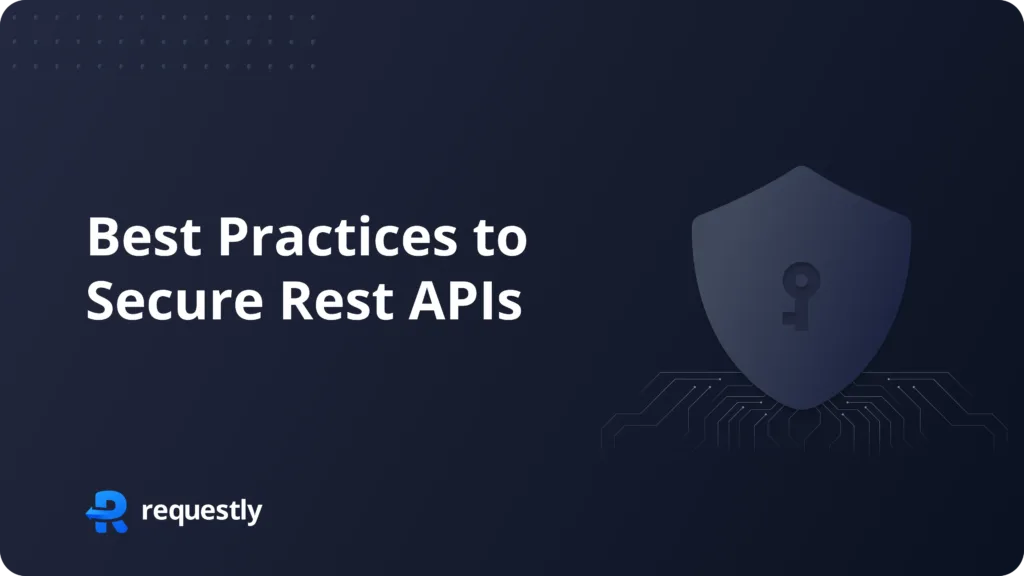How to secure your REST API: Design Principles and Best Practices

REST APIs have been crucial for robust integrations in web apps, but securing them can be challenging. REST (Representational State Transfer) principles help you implement stateless communications between systems through APIs. In other words, the current state of the web app is not stored. To ensure the safety of your data and prevent unauthorized access, it is essential to secure your REST API by following best practices and design principles
While this benefits many businesses, securing communication with REST API becomes crucial. For example, a cyberattack on Azure API due to a Server-side request forgery (SSRF) attack was making access to Azure functions vulnerable.
So, how do you ensure REST API security?
This article focuses on what is REST API and how to secure it through design principles and best practices.
What is a REST API?
REST is an architecture pattern used for web development. It is used with HTTP communication. RESTful APIs are the best option to implement REST. It is an application programming interface that helps you use the REST principles, and to access it, you need to connect through HTTP URLs.
REST APIs leverage standard HTTP approaches and status codes. It uses JSON as the standard data format. However, you need to understand that REST inherently is not a standard data format, and there are other web API formats that you can use, like XML-based SOAP API.
HTTP protocols are stateless, and so are REST APIs. This means that REST APIS doesn’t store any information about the current state of the system. You can use RESTful web services to access and manipulate data while the application handles session management.
Why do you need to secure your REST API?
REST API security is crucial to maintain the integrity of your business systems. The vulnerabilities and weaknesses in your REST API can lead to cyberattacks, exposing the network to a wide array of malicious injections.
Especially if you are using client-based tools to interact with the app from an external application, the vulnerabilities can lead to data leaks. REST API security ensures that sensitive data is secure and that the interaction between your system and external apps is protected against cyber attacks.
So, how do you ensure REST API security?
The answer lies in the design of your system.
Design principles that you can implement to secure your REST API.
Jerone Saltzer and Michael Schroeder’s paper on “The Protection of Information in Computer Systems.” provides critical design principles that you can use to secure your REST API .
Least privilege principle
Assigning permissions for data access within your system needs to be minimal and specific to a task. This requires assigning roles and ensuring data access privileges. Design the structure of your API integrations and system architecture to ensure data access privileges are kept to a minimum.
Explicit permissions
Design the system so that, by default, the data access for users is limited. If there is explicit permission for the data access, users will have the information they need. To ensure you have restrictive access by default, implement a fail-safe policy.
Access validation mechanism
You need to implement a system that can validate access rights to all the resources. It helps ensure users can access the data securely without relying on the cached permission matrix.
Least common mechanism
This mechanism is based on dependencies. Design your REST API integrations to ensure minimal risk of sharing state among different components. If the least common mechanism is not in place, it can lead to one corrupt shared state affecting all the dependent components.
Segregation of data privileges
You must design a data privilege policy for granting access to sensitive information according to multiple factors. If you are granting privileges based on a single factor, it can lead to abuse of data access and information leakages.
Implementing these design principles can help you secure your REST API , but you need to go beyond them for enhanced protection. The reason is simple: if you only focus on the internal structure and don’t secure external communications with the APIs, it can affect the security.
Best practices to secure your REST API
From using SSL certificates for your websites to enabling advanced authentication, there are many best practices that you can implement to ensure REST API security.
Use SSL/TLS certificates.
Web API security requires secure communications to ensure users can access data without compromising information security. SSL certificates help you secure the communications between server and browser through encryption.
You can get an SSL certificate from leading certification authorities like Comodo, Digicert, and GoDaddy. However, you must be mindful of the type of certificate to choose. For example, you can secure a web API leveraging a Comodo SSL certificate, but to secure many websites, you may need a Comodo wildcard certificate.
Leverage OAuth2 to enable single sign-on (SSO)
Every application has user credentials associated with a profile. So when a user tries to log in or out, these credentials help verify the user. App developers earlier used to write the login code manually, but with OAuth2, you can automate the entire authentication process, enabling single sign-on.
SSO verifies the users with a token exchange process for data access. It allows you to ensure REST API security without managing passwords and large volumes of user data.
Configure programmatic data access with API keys
REST endpoints serve your website, and enabling SSO makes the verification easier. However, if users login through SSO locally, it may not be secure because of the local network on which the process happens. In other words, users may log in while in the local environment. The security of the local network that users use is a significant concern.
One way to resolve this problem is by using API keys and configuring the programmatic data access. Here is how you can configure programmatic data access,
- Generate API keys for data access when a user signs
- Store the API keys in the database
- Share the API keys with users as per the data access policy
- Keep it hidden from users until regeneration is needed
- Ask your users to provide API keys shared as header
- Math the shared APIs with the ones stored in your database for authentication
So, each time a user generates API keys, ask users to add a label to the data. This labeled data helps regenerate API keys and even recover compromised login credentials.
Key takeaways
REST API security can help you improve system protection against cyberattacks by integrating third-party apps and services. While REST APIs provide several benefits, securing them requires the implementation of fundamental design principles. However, to ensure API interaction and communication security, you must use best practices like SSL certification and SSO.
Contents
- What is a REST API?
- Why do you need to secure your REST API?
- Design principles that you can implement to secure your REST API.
- Least privilege principle
- Explicit permissions
- Access validation mechanism
- Least common mechanism
- Segregation of data privileges
- Best practices to secure your REST API
- Use SSL/TLS certificates.
- Leverage OAuth2 to enable single sign-on (SSO)
- Configure programmatic data access with API keys
- Key takeaways
Subscribe for latest updates
Share this article
Related posts



















